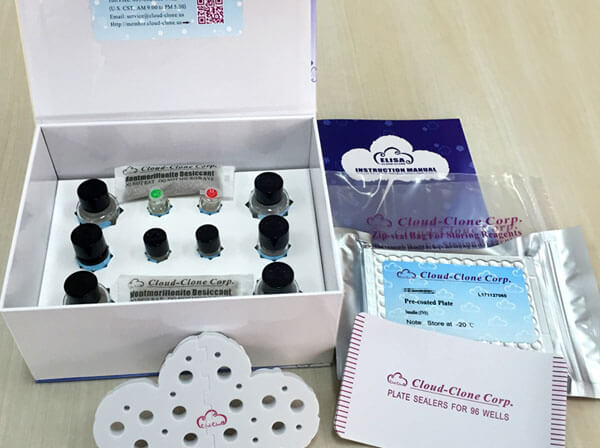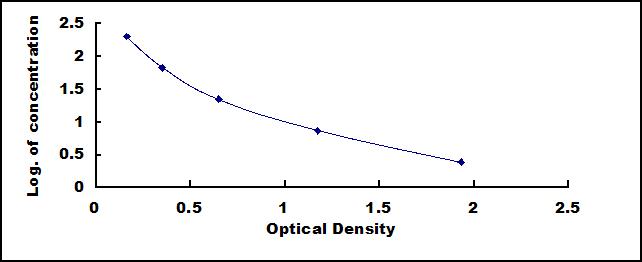ELISA Kit for Procollagen III C-Terminal Propeptide (PIIICP) 

P3CP; C-Propeptide Of Type III Procollagen; Procollagen III Carboxy Terminal Propeptide
- UOM
- FOB US$ 479.00 US$ 684.00 US$ 3,078.00 US$ 5,814.00 US$ 47,880.00
- Quantity
Overview
Properties
- Product No.CEA963Mu
- Organism SpeciesMus musculus (Mouse) Same name, Different species.
- ApplicationsEnzyme-linked immunosorbent assay for Antigen Detection.
Research use only - DownloadInstruction Manual
- CategoryMetabolic pathwayBone metabolism
Sign into your account
Share a new citation as an author
Upload your experimental result
Review

Contact us
Please fill in the blank.
Recovery
Matrices listed below were spiked with certain level of recombinant Procollagen III C-Terminal Propeptide (PIIICP) and the recovery rates were calculated by comparing the measured value to the expected amount of Procollagen III C-Terminal Propeptide (PIIICP) in samples.
| Matrix | Recovery range (%) | Average(%) |
| serum(n=5) | 98-105 | 101 |
| EDTA plasma(n=5) | 87-104 | 99 |
| heparin plasma(n=5) | 79-90 | 83 |
Precision
Intra-assay Precision (Precision within an assay): 3 samples with low, middle and high level Procollagen III C-Terminal Propeptide (PIIICP) were tested 20 times on one plate, respectively.
Inter-assay Precision (Precision between assays): 3 samples with low, middle and high level Procollagen III C-Terminal Propeptide (PIIICP) were tested on 3 different plates, 8 replicates in each plate.
CV(%) = SD/meanX100
Intra-Assay: CV<10%
Inter-Assay: CV<12%
Linearity
The linearity of the kit was assayed by testing samples spiked with appropriate concentration of Procollagen III C-Terminal Propeptide (PIIICP) and their serial dilutions. The results were demonstrated by the percentage of calculated concentration to the expected.
| Sample | 1:2 | 1:4 | 1:8 | 1:16 |
| serum(n=5) | 78-91% | 79-103% | 94-102% | 87-103% |
| EDTA plasma(n=5) | 88-102% | 96-103% | 89-102% | 80-88% |
| heparin plasma(n=5) | 91-98% | 85-92% | 94-104% | 78-92% |
Stability
The stability of kit is determined by the loss rate of activity. The loss rate of this kit is less than 5% within the expiration date under appropriate storage condition.
To minimize extra influence on the performance, operation procedures and lab conditions, especially room temperature, air humidity, incubator temperature should be strictly controlled. It is also strongly suggested that the whole assay is performed by the same operator from the beginning to the end.
Reagents and materials provided
| Reagents | Quantity | Reagents | Quantity |
| Pre-coated, ready to use 96-well strip plate | 1 | Plate sealer for 96 wells | 4 |
| Standard | 2 | Standard Diluent | 1×20mL |
| Detection Reagent A | 1×120µL | Assay Diluent A | 1×12mL |
| Detection Reagent B | 1×120µL | Assay Diluent B | 1×12mL |
| TMB Substrate | 1×9mL | Stop Solution | 1×6mL |
| Wash Buffer (30 × concentrate) | 1×20mL | Instruction manual | 1 |
Assay procedure summary
1. Prepare all reagents, samples and standards;
2. Add 50µL standard or sample to each well.
And then add 50µL prepared Detection Reagent A immediately.
Shake and mix. Incubate 1 hour at 37°C;
3. Aspirate and wash 3 times;
4. Add 100µL prepared Detection Reagent B. Incubate 30 minutes at 37°C;
5. Aspirate and wash 5 times;
6. Add 90µL Substrate Solution. Incubate 10-20 minutes at 37°C;
7. Add 50µL Stop Solution. Read at 450 nm immediately.

Test principle
This assay employs the competitive inhibition enzyme immunoassay technique. A monoclonal antibody specific to Procollagen III C-Terminal Propeptide (PIIICP) has been pre-coated onto a microplate. A competitive inhibition reaction is launched between biotin labeled Procollagen III C-Terminal Propeptide (PIIICP) and unlabeled Procollagen III C-Terminal Propeptide (PIIICP) (Standards or samples) with the pre-coated antibody specific to Procollagen III C-Terminal Propeptide (PIIICP). After incubation the unbound conjugate is washed off. Next, avidin conjugated to Horseradish Peroxidase (HRP) is added to each microplate well and incubated. The amount of bound HRP conjugate is reverse proportional to the concentration of Procollagen III C-Terminal Propeptide (PIIICP) in the sample. After addition of the substrate solution, the intensity of color developed is reverse proportional to the concentration of Procollagen III C-Terminal Propeptide (PIIICP) in the sample.
Giveaways
Increment services
Citations
- Fibrosis of extracellular matrix is related to the duration of the disease but is unrelated to the dynamics of collagen metabolism in dilated cardiomyopathypubmed:27516211
- Left ventricular reverse remodeling is not related to biopsy-detected extracellular matrix fibrosis and serum markers of fibrosis in dilated cardiomyopathy, regardless of the definition used for LVRRpubmed:28004175
- Endothelial‑to‑mesenchymal transition in human idiopathic dilated cardiomyopathypubmed:29115553
- Left ventricular reverse remodeling is not related to biopsy‑detected extracellular matrix fibrosis and serum markers of fibrosis in dilated cardiomyopathy, regardless of the definition used for LVRR10.1007/s00380-016-0930-y
- 12-month patterns of serum markers of collagen synthesis, transforming growth factor and connective tissue growth factor are similar in new-onset and chronic dilated cardiomyopathy in patients both with and without cardiac fibrosis.pubmed:28460256
- Prognostic value of fibrosis-related markers in dilated cardiomyopathy: A link between osteopontin and cardiovascular events.pubmed:29120858
- Extracellular matrix collagen biomarkers levels in patients with chronic thromboembolic pulmonary hypertensionPubmed: 33175289











